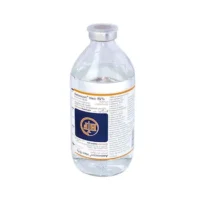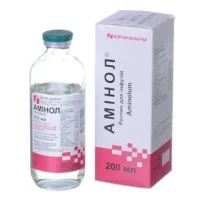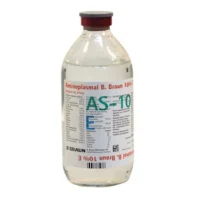Description
Aminoven 10% Solution for Infusions 1000 ml Vial №1
Ingredients
Aminoven 10% solution contains essential amino acids, electrolytes, and glucose in a balanced formulation to support protein synthesis and metabolic functions in the body.
Mechanism of Action
Aminoven 10% solution acts by providing essential amino acids, electrolytes, and glucose intravenously to support protein synthesis and metabolic functions, particularly in patients with increased nutritional needs.
Pharmacological Properties
Pharmacological Effects: Aminoven 10% solution provides a source of nitrogen and energy to support protein synthesis, cellular function, and tissue repair in patients with increased metabolic demands.
Indications
Aminoven 10% solution is indicated for patients requiring parenteral nutrition to meet their daily amino acid and energy requirements when oral or enteral nutrition is not feasible or sufficient.
Contraindications
Contraindications: Do not use Aminoven 10% solution in patients with hypersensitivity to any component of the product, severe liver failure, or severe kidney impairment without medical supervision.
Side Effects
Side Effects: Common side effects of Aminoven 10% solution may include hypersensitivity reactions, electrolyte imbalances, and metabolic complications. Monitoring for adverse reactions is essential during treatment.
Usage Instructions
Directions: Administer Aminoven 10% solution using a sterile technique and infusion equipment. Monitor the patient for any signs of intolerance or complications during and after infusion.
Benefits Compared to Analogues
Benefits: Aminoven 10% solution offers a balanced formulation of essential nutrients for patients requiring parenteral nutrition, with a well-tolerated profile and demonstrated efficacy in supporting protein synthesis and metabolic functions.
Suitable Patient Groups
Suitable Patient Groups: Aminoven 10% solution is suitable for a wide range of patient populations, including adults, children, and the elderly, who require parenteral nutrition support to meet their nutritional needs.
Storage and Shelf Life
Storage: Store Aminoven 10% solution as per the manufacturer’s instructions, avoiding exposure to extreme temperatures. Check the expiration date on the packaging and do not use expired products.
Packaging Description
Packaging: Aminoven 10% solution is available in 1000 ml vials for intravenous infusions, ensuring convenient and accurate dosing for healthcare professionals.
Clinical Evidence and Proven Effectiveness
Clinical Trials: Clinical trials have demonstrated the benefits of parenteral nutrition with amino acid solutions like Aminoven in improving clinical outcomes and reducing complications in critically ill patients.





